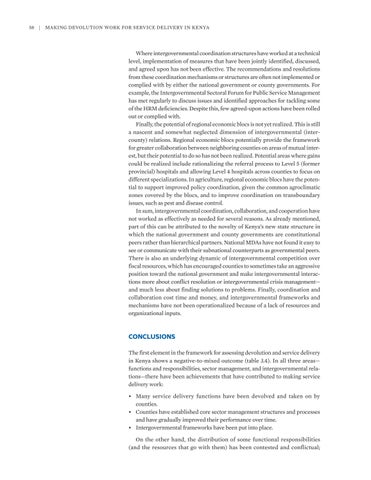58
|
Making Devolution Work for Service Delivery in Kenya
Where intergovernmental coordination structures have worked at a technical level, implementation of measures that have been jointly identified, discussed, and agreed upon has not been effective. The recommendations and resolutions from these coordination mechanisms or structures are often not implemented or complied with by either the national government or county governments. For example, the Intergovernmental Sectoral Forum for Public Service Management has met regularly to discuss issues and identified approaches for tackling some of the HRM deficiencies. Despite this, few agreed-upon actions have been rolled out or complied with. Finally, the potential of regional economic blocs is not yet realized. This is still a nascent and somewhat neglected dimension of intergovernmental (intercounty) relations. Regional economic blocs potentially provide the framework for greater collaboration between neighboring counties on areas of mutual interest, but their potential to do so has not been realized. Potential areas where gains could be realized include rationalizing the referral process to Level 5 (former provincial) hospitals and allowing Level 4 hospitals across counties to focus on different specializations. In agriculture, regional economic blocs have the potential to support improved policy coordination, given the common agroclimatic zones covered by the blocs, and to improve coordination on transboundary issues, such as pest and disease control. In sum, intergovernmental coordination, collaboration, and cooperation have not worked as effectively as needed for several reasons. As already mentioned, part of this can be attributed to the novelty of Kenya’s new state structure in which the national government and county governments are constitutional peers rather than hierarchical partners. National MDAs have not found it easy to see or communicate with their subnational counterparts as governmental peers. There is also an underlying dynamic of intergovernmental competition over fiscal resources, which has encouraged counties to sometimes take an aggressive position toward the national government and make intergovernmental interactions more about conflict resolution or intergovernmental crisis management— and much less about finding solutions to problems. Finally, coordination and collaboration cost time and money, and intergovernmental frameworks and mechanisms have not been operationalized because of a lack of resources and organizational inputs.
CONCLUSIONS The first element in the framework for assessing devolution and service delivery in Kenya shows a negative-to-mixed outcome (table 3.4). In all three areas— functions and responsibilities, sector management, and intergovernmental relations—there have been achievements that have contributed to making service delivery work: • Many service delivery functions have been devolved and taken on by counties. • Counties have established core sector management structures and processes and have gradually improved their performance over time. • Intergovernmental frameworks have been put into place. On the other hand, the distribution of some functional responsibilities (and the resources that go with them) has been contested and conflictual;


